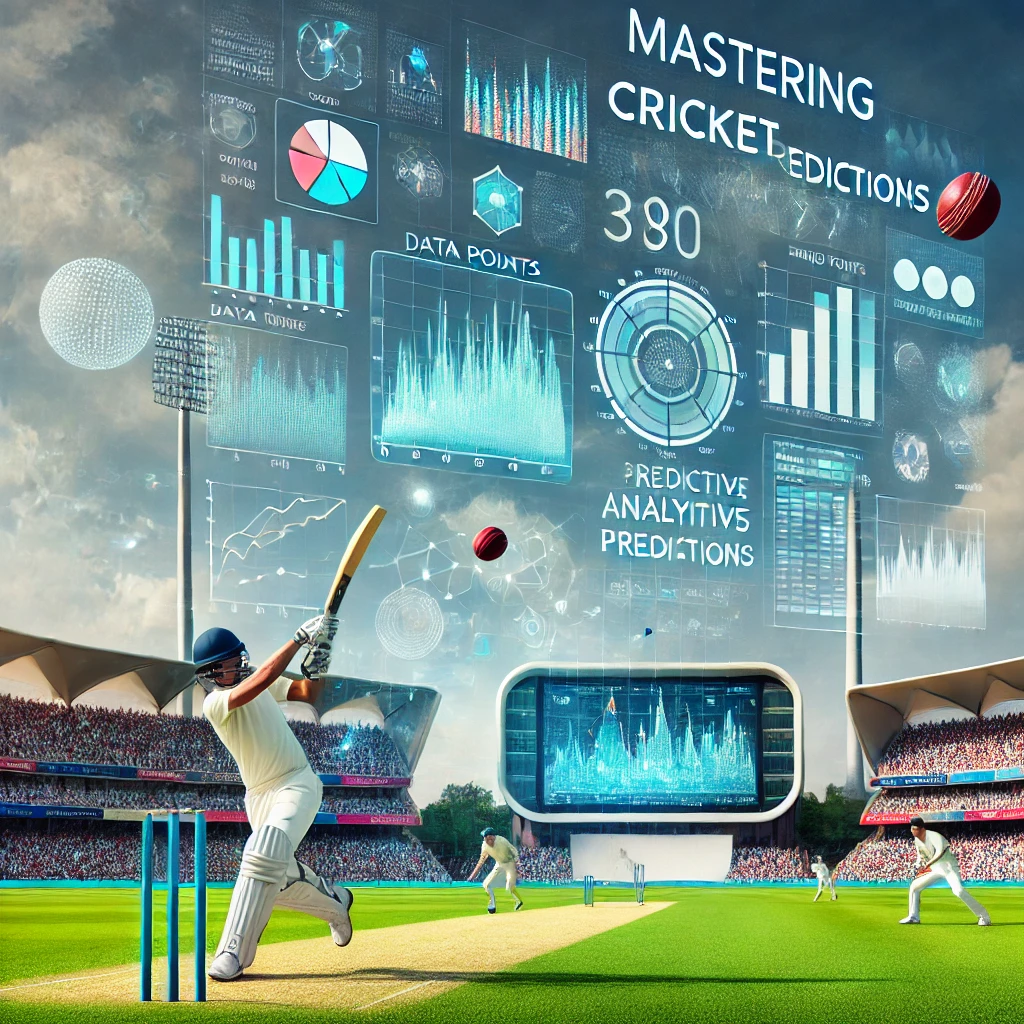Dream11 Prediction for Today’s Match : Mastering Cricket Predictions: Strategies, Analytics, and Key Insights for Accurate Forecasting
Cricket is not just a game of bat and ball; it is a complex mix of strategy, skill and, sometimes, outright uncertainty. For ardent fans, fantasy sports enthusiasts and betting investors, predicting cricket outcomes remains an exciting and often lucrative challenge.
But with so many uncertainties – from pitch conditions to player form – how can one make accurate predictions? In this article, we explore strategies, data-driven insights and expert tips that can help you anticipate the game’s ups and downs and make more accurate cricket predictions.
Understanding the Basics of Cricket Prediction
Cricket prediction involves forecasting different aspects of the game based on historical data, player performance, team dynamics, and match conditions. It is a multifaceted process where enthusiasts and experts try to predict important outcomes, whether for betting purposes, for fantasy sports, or simply out of love for the game. Predictions can vary depending on which aspect of the match is focused on.
Here are some of the main elements of a cricket prediction:
Match Result: This is the most common prediction. Who will win the match? It involves analyzing the strengths and weaknesses of both teams, recent form, head-to-head statistics, and external factors like weather and pitch conditions. For example, predicting a team’s chances of winning a Test match versus a T20 game requires different considerations, as the two formats emphasize different skills and strategies. Read Also : Who is Nahid Rana bowler from Bangladesh that Team India needs to be careful
Player Performance: This type of prediction focuses on individual player contributions. Who will be the top scorer? Which bowler will take the most wickets? Predicting performance involves taking into account the recent form of players, their record against the opponent, and how well they adapt to specific conditions such as spin-friendly or pace-friendly pitches. Fantasy cricket players focus particularly on this aspect when choosing their team lineup.

In-Game Moments: Cricket predictions can also go into specific scenarios within the match. Examples include predicting the total runs scored in a particular over, the first wicket to fall, or how many boundaries will be hit. These micro-predictions add another layer of excitement to the game and are often preferred in live betting markets.
1. Team Form & Head-to-Head Statistics
- Team Form: The recent performance of a team is a crucial indicator. Teams in winning form typically have momentum, which boosts confidence and execution on the field.
- Head-to-Head Statistics: Historical matchups between two teams can reveal patterns, such as a team’s consistent dominance over another. These stats often account for the psychological edge some teams have.
2. Player Form & Injuries
- Player Form: Individual performance trends are essential. Key players in good form (e.g., top batsmen or bowlers) significantly improve a team’s chances of success.
- Injuries: Injuries to key players can weaken a team’s overall balance, impacting performance. An unexpected injury during the match can also alter the game dynamics.
3. Pitch Conditions
- Batting-Friendly Pitch: Flat pitches with little grass allow batsmen to play freely, leading to high scores. A well-maintained pitch may favor stroke play over spin or seam bowling.
- Bowler-Friendly Pitch: Green pitches with uneven bounce benefit seamers, while dry, cracked surfaces may support spinners. Understanding the pitch’s nature helps forecast possible high or low scoring matches.
4. Weather Conditions
- Rain: Rain interruptions, especially in limited-overs formats, can reduce the number of overs and influence the required run rate under the Duckworth-Lewis method. Wet outfields can also affect bowling and fielding.
- Humidity: Humidity can make the ball swing more, especially in overcast conditions, benefiting bowlers. Conversely, dry weather can assist spinners due to the increased grip on the ball.
- Dew Factor: In day/night matches, dew makes the ball slippery for bowlers, especially spinners, making it difficult to grip and control.
5. Venue Insights
- Home Advantage: Teams playing at their home ground often perform better due to familiarity with the pitch and conditions, as well as local crowd support.
- Venue-Specific Trends: Some venues traditionally favor certain types of play, such as fast bowling in pace-friendly stadiums (e.g., Perth) or spin-friendly pitches (e.g., Chennai).
6. Toss Importance
- Influence of Toss: Winning the toss can provide a strategic advantage. Teams may choose to bat first to avoid deteriorating pitch conditions or to exploit the dew factor in the evening. In Test matches, choosing the right time to bat is critical, as the pitch condition changes over five days.
- Day/Night Matches: In limited-overs matches, the toss is particularly important in day/night games, as teams batting under lights may face challenging conditions, like ball movement under the floodlights.
Data and Analytics in Cricket Prediction
In the modern era, data and analytics play a pivotal role in predicting cricket outcomes. With technological advancements, the use of data-driven insights has transformed the way matches are analyzed, offering more accurate and comprehensive predictions. Let’s break down how data and analytics contribute to cricket predictions:
1. Use of Historical Data
- Analyzing Past Performances: Historical data allows analysts to examine past performances of both teams and individual players. It includes metrics like batting averages, bowling economies, strike rates, win/loss records, and partnerships.
- Tracking Patterns: Data can reveal patterns such as how a player or team performs in specific conditions, against certain opponents, or during particular stages of the game (e.g., powerplays or death overs). This insight helps in forecasting future performances.
- Match Context: Analyzing the context of matches (home vs. away, day vs. night, knockout stages) from historical data gives a more nuanced understanding of how teams and players react in different scenarios. For example, certain teams may excel in pressure situations or perform better in specific conditions like swing-friendly pitches or hot, dry weather.
2. Algorithms & AI
- Machine Learning Models: Modern cricket predictions use machine learning algorithms to analyze vast datasets and identify relationships between different variables. These models can process player stats, match conditions, and real-time data to forecast likely outcomes, such as team scores, individual player contributions, and match results.
- Multivariable Analysis: AI-powered models take into account numerous factors, including pitch conditions, weather data, toss outcomes, recent form, and even crowd noise. This multi-dimensional approach increases the accuracy of predictions by weighting each factor based on its historical importance.
- Real-Time Updates: During a match, algorithms can adapt and update predictions in real time. For example, if a key player gets injured or the pitch starts behaving unexpectedly, AI systems recalibrate predictions instantly.
- Player Matchups: Some models focus on individual player matchups, such as how a bowler historically performs against a specific batsman or how effective a bowler is at particular stages of an innings. This insight can be critical when predicting wickets or boundaries. Read Also: Vienna Cricket Club: A Pillar of Austrian Cricket Since 1975
3. Big Data in Cricket
- Player Averages, Strike Rates, and Bowling Economy: Statistical metrics like batting average, strike rate (runs per 100 balls), and bowling economy (runs conceded per over) are foundational elements in cricket analytics. These statistics are used to evaluate player consistency, efficiency, and impact.
- Advanced Metrics: Big data tools have also led to the development of more complex statistics, such as:
- Expected Runs (xR): The predicted number of runs a player or team should score based on past data.
- Win Probability (WP): This metric predicts a team’s chances of winning at any given stage of the match, based on historical data from similar match situations.
- Fielding Analytics: With the aid of video analytics and tracking systems, data on fielding positions, reaction times, and run-out chances can be used to predict fielding efficiency and game-turning moments.
- Shot Tracking & Player Heatmaps: Using big data, analysts can track individual shot choices of a batsman (e.g., how often they hit through cover or play sweep shots). Similarly, bowlers’ lengths and line heatmaps help assess their consistency and effectiveness.
The Role of Technology in Data Collection
- Hawk-Eye & Ball Tracking: Systems like Hawk-Eye track the ball’s trajectory, speed, and angles, which provide insights into how certain pitches behave, aiding in predicting bowling effectiveness.
- Wearable Tech & Sensors: Players now use wearable tech that tracks their movements, fatigue levels, and even heart rates. This data helps in injury prevention and recovery analysis, which indirectly influences form and performance predictions.
- Player & Pitch Cameras: High-definition cameras placed around stadiums provide real-time data on player movements, field settings, and pitch conditions. This data can be fed into models to simulate match scenarios and predict outcomes based on small changes in tactics.
5. Strategies for Making Cricket Predictions
Making accurate cricket predictions requires a well-rounded approach, combining research, observation, and strategic thinking. Below are some practical strategies you can use to improve your predictions:
1. Follow Team News Closely
- Injuries and Squad Changes: Staying up-to-date with the latest team news is crucial. Injuries to key players or changes in the squad can have a significant impact on a team’s chances. If a team’s star batsman or top bowler is out injured, it may affect their balance and performance.
- Team Morale: Besides individual injuries, team morale plays a huge role. Teams coming off a winning streak often have momentum, while teams that have faced recent controversies or losses may struggle to perform.
- Player Rest and Rotation: In busy schedules, teams often rotate players to manage fatigue, which can affect performance. Make sure you check if the full-strength squad is available for a match.
2. Study the Pitch Reports
- Pitch Behavior: Each cricket ground has unique characteristics. Some pitches are more favorable to batsmen, offering consistent bounce and pace, while others may favor seamers or spinners. Before making predictions, read pitch reports and understand how the pitch is likely to behave on that particular day.
- Pitch Wear and Tear: In Test matches, pitch conditions can change over the course of five days. A pitch may be good for batting on the first day but deteriorate and offer more spin or variable bounce as the match progresses. This can affect the outcomes of different innings.
- Ground Size and Conditions: Small grounds with shorter boundaries may result in higher scores, especially in T20s and ODIs, whereas larger grounds can favor bowlers.
3. Look for Patterns in Player Performance
- Track Consistency: Some players are more consistent than others. A player’s form in recent matches, particularly under similar conditions, is a strong indicator of how they will perform. Look at stats like batting average, strike rate, and how well bowlers have taken wickets.
- Analyze Performance in Specific Conditions: Some batsmen are better at playing on fast, bouncy tracks, while others prefer spin-friendly pitches. Similarly, bowlers might perform better in overcast, swing-friendly conditions or on slow, dry pitches.
- Player Matchups: Some bowlers consistently trouble certain batsmen, or vice versa. These head-to-head statistics can offer valuable insights when predicting individual performances.
4. Consider Weather Forecasts
- Check for Rain: Rain interruptions, particularly in shorter formats like ODIs and T20s, can lead to a reduced number of overs and change the dynamics of the game through the Duckworth-Lewis-Stern (DLS) method. Teams batting second in a rain-affected game often have a clearer idea of the target and tend to be at an advantage.
- Overcast or Humid Conditions: Overcast skies and humid conditions can help fast bowlers swing the ball, making it more difficult for batsmen. In these conditions, teams with strong pace attacks tend to have the upper hand.
- Dew Factor: In day/night matches, the dew can make the ball slippery, making it harder for bowlers, especially spinners, to control the ball. Teams may prefer to bowl first in these conditions to avoid bowling with a wet ball in the second innings.
5. Understand the Format
- Test Cricket: In Tests, endurance, patience, and skill over long periods are key. Predicting in Test matches requires considering how teams and players will adapt to changing conditions over five days. Some teams specialize in grinding out draws, while others push aggressively for wins.
- One-Day Internationals (ODIs): ODIs are about balancing risk and reward over 50 overs. Teams tend to strategize around setting or chasing a competitive target, depending on the pitch and conditions. Look at how well teams perform in middle overs and during death overs for better predictions.
- T20 Cricket: T20s are high-paced, with aggressive batting and fast wicket-taking being the norm. Teams with strong hitters and death bowlers have an edge. In this format, momentum shifts quickly, so pay attention to players who thrive under pressure and in high-stakes moments.
- Match Context: Whether it’s a league stage, knockout, or final, the pressure and stakes influence a team’s approach. Teams often perform differently in high-pressure matches, so consider their history in such situations.
Conclusion
Modern cricket predictions have evolved beyond mere intuition to rely heavily on data-driven analysis. Historical data, advanced algorithms, and big data metrics provide comprehensive insights that help analysts and fans alike predict match outcomes with increasing precision. Analytics not only support pre-match predictions but also enhance real-time decision-making during the game, creating a more informed and strategic approach to cricket.
FAQ
How many players are there in the US cricket team?
There are fewer than 200,000 cricket players in the United States, which is less than 0.1% of the population
What is the eligibility criteria to play for the USA cricket team?
To be eligible to play for the USA cricket team, a player must have been a resident of the United States for the three years prior to submitting their information to the ICC.
What is the membership fee for USA Cricket?
The membership fee for USA Cricket is $10 per member, regardless of the role they select.
How can existing members log in to the USA Cricket portal?
Existing members can log in to the new portal by using the "Existing Member Login" option on the Login page. They will need to verify their email ID or phone number and set a new password.






